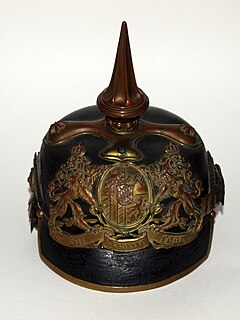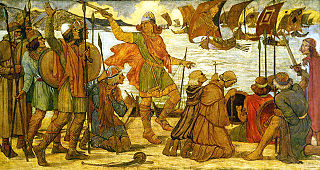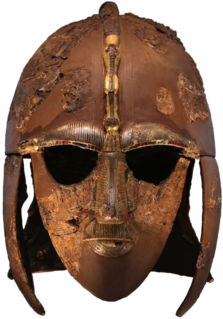
Boiled leather, often referred to by its French translation, cuir bouilli, was a historical material for various uses common in the Middle Ages and Early Modern Period. It was leather that had been treated so that it became tough and rigid, as well as able to hold moulded decoration. It was the usual material for the robust carrying-cases that were made for important pieces of metalwork, instruments such as astrolabes, personal sets of cutlery, books, pens and the like. It was used for some armour, being both much cheaper and much lighter than plate armour, but could not withstand a direct blow from a blade, nor a gunshot.

The Pickelhaube, also Pickelhelm, is a spiked helmet worn in the 19th and 20th centuries by Prussian and German military, firefighters and police. Although typically associated with the Prussian Army, which adopted it in 1842–43, the helmet was widely imitated by other armies during that period. It is still worn today as part of ceremonial wear in the militaries of certain countries, such as Sweden, Chile, and Colombia.

A hard hat is a type of helmet predominantly used in workplace environments such as industrial or construction sites to protect the head from injury due to falling objects, impact with other objects, debris, rain, and electric shock. Suspension bands inside the helmet spread the helmet's weight and the force of any impact over the top of the head. A suspension also provides space of approximately 30 mm between the helmet's shell and the wearer's head, so that if an object strikes the shell, the impact is less likely to be transmitted directly to the skull. Some helmet shells have a mid-line reinforcement ridge to improve impact resistance. The rock climbing helmet fulfills a very similar role in a different context and has a very similar design.

The Brodie helmet is a steel combat helmet designed and patented in London in 1915 by John Leopold Brodie. A modified form of it became the Helmet, Steel, Mark I in Britain and the M1917 Helmet in the U.S. Colloquially, it was called the shrapnel helmet, battle bowler, Tommy helmet, tin hat, and in the United States the doughboy helmet. It was also known as the dishpan hat, tin pan hat, washbasin, battle bowler, and Kelly helmet. The German Army called it the Salatschüssel. The term Brodie is often misused. It is correctly applied only to the original 1915 Brodie's Steel Helmet, War Office Pattern.

A greave or jambeau is a piece of armour that protects the leg.

The Stahlhelm is a specific type of German military headgear made of steel, which is primarily intended to provide protection against shrapnel and fragments of grenades. The term Stahlhelm refers both to a generic steel helmet, and more specifically to the distinctive German military design.

The M1 helmet is a combat helmet that was used by the U.S. military from World War II until 1985, when it was succeeded by the PASGT helmet. The M1 helmet has become an icon of the US military, with its design inspiring other militaries around the world.

Knowledge about military technology of the Viking Age is based on relatively sparse archaeological finds, pictorial representation, and to some extent on the accounts in the Norse sagas and laws recorded in the 14th century.

The football helmet is a piece of protective equipment used mainly in gridiron football. It consists of a hard plastic shell with thick padding on the inside, a face mask made of one or more plastic-coated metal bars, and a chinstrap. Each position has a different type of face mask to balance protection and visibility, and some players add polycarbonate visors to their helmets, which are used to protect their eyes from glare and impacts. Helmets are a requirement at all levels of organized football, except for non-tackle variations such as flag football. Although they are protective, players can and do still suffer head injuries such as concussions.

In ice hockey, the goaltender wears specialized goaltending equipment to protect himself from the impact of the puck and to assist himself in making saves.

The Coppergate Helmet is an eighth-century Anglo-Saxon helmet found in York, England. It was discovered in May 1982 during excavations for the Jorvik Viking Centre at the bottom of a pit that is thought to have once been a well.

Protective equipment in gridiron football consists of equipment worn by football players for the protection of the body during the course of a football game. Basic equipment worn by most football players include helmet, shoulder pads, gloves, shoes, and thigh and knee pads, a mouthguard, and a jockstrap or compression shorts with or without a protective cup. Neck rolls, elbow pads, hip pads, tailbone pads, rib pads, and other equipment may be worn in addition to the aforementioned basics. Football protective equipment is made of synthetic materials: foam rubbers, elastics, and durable, shock-resistant, molded plastic. Football protective equipment has remained consistent in use for decades with some slight modifications made over the years in design and materials. The assignment and maintenance of football gear belongs to the team equipment manager.

The Sutton Hoo helmet is an ornately decorated Anglo-Saxon helmet found during a 1939 excavation of the Sutton Hoo ship-burial. It was buried around 625 and is widely believed to have belonged to King Rædwald of East Anglia; its elaborate decoration may have given it a secondary function akin to a crown. The helmet was both a functional piece of armour that would have offered considerable protection if ever used in warfare, and a decorative, prestigious piece of extravagant metalwork. It is described as "the most iconic object" from "one of the most spectacular archaeological discoveries ever made", and perhaps the most important known Anglo-Saxon artefact.

The Luftwaffe was the air force of Nazi Germany prior to and during World War II. Luftwaffe styles of uniform and rank insignia had many unique features between 1935 and 1945. By Hitler's decision on February 26, 1935, the Luftwaffe was to be officially the third branch of the Wehrmacht as of March 1, 1935. The new Luftwaffe was faced with the problem of uniforms, as they wanted a uniform distinct from those of the other two branches of the Wehrmacht and also wanted a clear differentiation in dress of military and civilian flyers.

The Shorwell helmet is an Anglo-Saxon helmet from the early to mid-sixth century AD found near Shorwell on the Isle of Wight in southern England. It was one of the grave goods of a high-status Anglo-Saxon warrior, and was found with other objects such as a pattern-welded sword and hanging bowl. One of only six known Anglo-Saxon helmets, alongside those from Benty Grange, Sutton Hoo, Coppergate, Wollaston, and Staffordshire, it is the sole example to derive from the continental Frankish style rather than the contemporaneous Northern "crested helmets" used in England and Scandinavia.

The Helmet Steel Airborne Troops (HSAT) is a paratrooper helmet of British origin worn by paratroopers and members of airlanding units. It was introduced in Second World War by the British Army and was also used by other Commonwealth armies. It continued to be used in the post-war era until the early 1980s. It was in the process of being replaced, with parachute battalions being issued as priority, when the Falklands War occurred. As with the similarly shaped RAC helmet and despatch rider motorcycle helmet, it was initially manufactured by Briggs Motor Bodies at Dagenham.

The Gjermundbu helmet is a Viking Age helmet.

The Tjele helmet fragment is a Viking Age fragment of iron and bronze, originally comprising the eyebrows and noseguard of a helmet. It was discovered in 1850 with a large assortment of smith's tools in Denmark, and though the find was sent to the National Museum of Denmark, for 134 years the fragment was mistaken for a saddle mount. In 1984 it was properly identified by an assistant keeper at the museum as the remainder of one of only five known helmets from the Viking era.

The Ssh-36 was a steel combat helmet developed and used by the Red Army. It was designed by Aleksandr A. Shvartz, and began production in 1936. Its large front rim and wide flares over the ears provided good protection for the wearer. The German M35, introduced a year before the Russian SSh-36, served as a model for the development of the SSh-36. The SSh-36 was also fitted with a comb on top, which allowed for ventilation. There were also apocryphal claims that the comb was designed to deflect saber blows.
The SSh-39 and SSh-40 were two similar designs of steel combat helmet designed and used by the Red Army. They were the main forms of helmet in use during World War II and had only superficial differences.



















